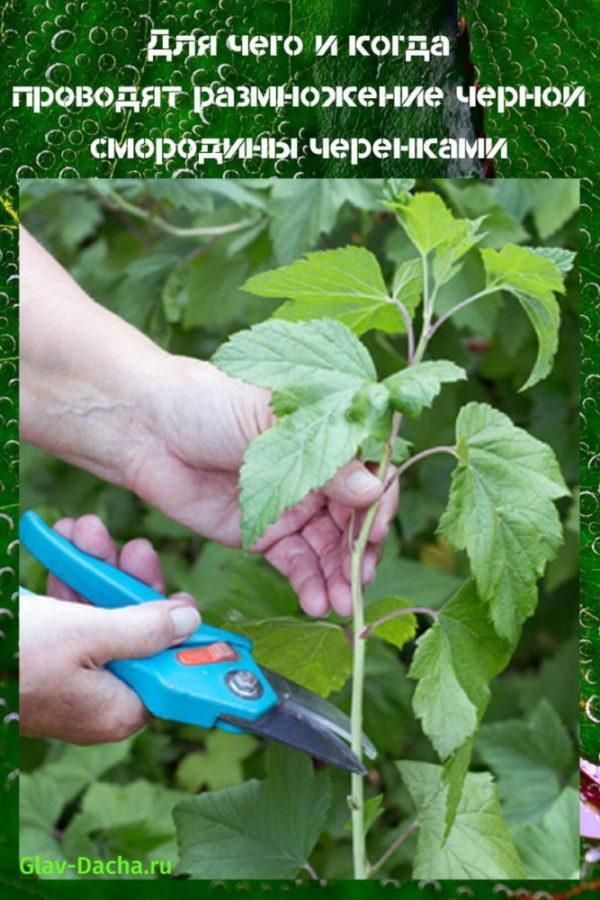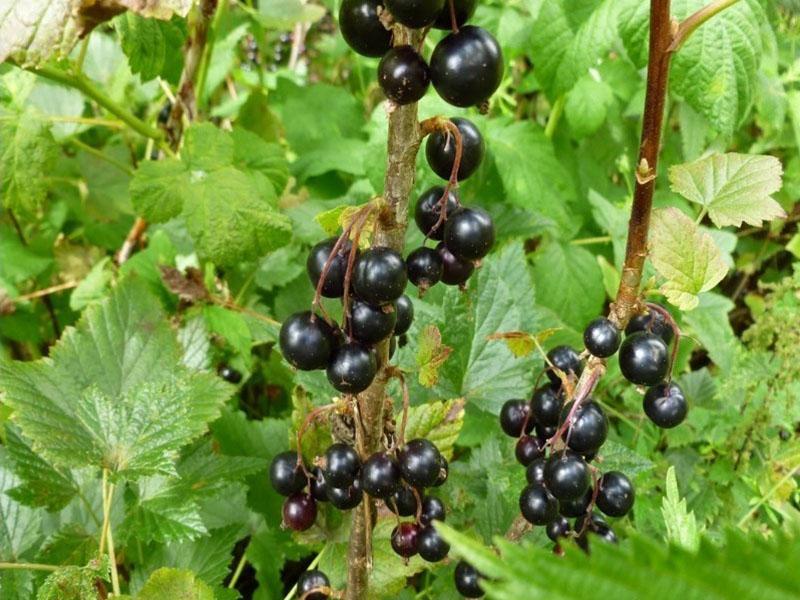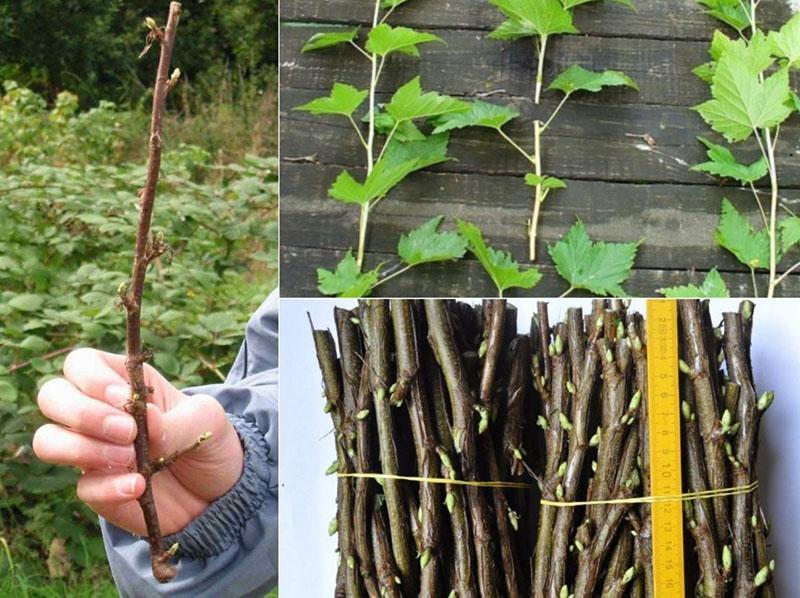Why and when are blackcurrant propagation by cuttings carried out?
 Mankind has long known about the benefits and taste of black currant. Every gardener, gardener and farmer is trying to get the maximum yield of delicious and very healthy berries. To do this, he uses the propagation of black currant by cuttings, seed.
Mankind has long known about the benefits and taste of black currant. Every gardener, gardener and farmer is trying to get the maximum yield of delicious and very healthy berries. To do this, he uses the propagation of black currant by cuttings, seed.

Advantages and disadvantages of the grafting method
 To get the maximum benefit and yield from the berry propagation procedure, it is necessary to familiarize yourself with the advantages and possible disadvantages of cuttings.
To get the maximum benefit and yield from the berry propagation procedure, it is necessary to familiarize yourself with the advantages and possible disadvantages of cuttings.
Pros:
- rejuvenation of old plants;
- increased productivity;
- improved fruiting;
- regulation of the required number of seedlings;
- timely updating of currant bushes;
- for carrying out activities for cuttings, financial investments are not required.
Reproduction of black currant by cuttings allows you to keep the varietal characteristics and flavoring properties of berries unchanged.
Minuses:
- when transplanting, not all petioles take root;
- seedlings require careful and attentive care;
- autumn planting activities for ready-made seedlings are not suitable for regions with cold climates.
The creation of special conditions for winter storage of cuttings is also considered a disadvantage of this method of breeding black currants.
Reproduction of black currant by cuttings: features
 Breeding activities for various varieties of black currant by cuttings are carried out in the fall, spring or summer. To obtain young seedlings, it is necessary to prepare planting material in a timely manner.
Breeding activities for various varieties of black currant by cuttings are carried out in the fall, spring or summer. To obtain young seedlings, it is necessary to prepare planting material in a timely manner.
The timing of harvesting seedlings depends on the method of cuttings and the climatic characteristics of the region where the berry crop is grown. If green petioles are harvested in early summer, woody planting material can be harvested at any time of the year.
Harvesting apical cuttings

Harvesting of future seedlings from apical cuttings begins at the beginning of the summer period. To do this, annual, young shoots are cut off from an adult bush:
- Activities for the preparation of petioles are carried out in the morning or after sunset.
- You will need a pruner or a sharp garden knife to work.
- Tools are carefully treated with a manganese solution.
- Selected shoots are cut and divided into several cuttings, 15 to 20 centimeters long.
- The cut of the cuttings is carried out obliquely, under the lower fruit bud.
Next, the seedlings are placed in a fertile soil mixture or container with water until the roots appear.
Apical cuttings are demanding on the conditions of keeping and growing, they root poorly and are difficult to take root in a new place. Therefore, this method of propagating currants is used only in case of a shortage of planting material.
Harvesting lignified cuttings
 Experienced gardeners and truck farmers use the method of propagating currants with lignified cuttings. Harvesting of planting material can be carried out both in autumn and in spring. The event is combined with sanitary or formative pruning of currant bushes.
Experienced gardeners and truck farmers use the method of propagating currants with lignified cuttings. Harvesting of planting material can be carried out both in autumn and in spring. The event is combined with sanitary or formative pruning of currant bushes.
For the procedure for breeding currants, an adult, healthy bush is chosen without signs of damage and damage from diseases and harmful insects:
- At the berry bush, choose the strongest annual cut with a hard bark.
- The branch diameter should be at least 7 millimeters.
- Cut off the cut from the mother bush with an oblique cut using a pre-processed garden knife or pruner.
- Next, the trimmed shoot is divided into several cuttings, 20 to 25 centimeters long.
- The top of each petiole is cut at a distance of 1 centimeter from the bud.
- The green part of the top of the branch is removed.
So that the cuttings do not dry out and are stored longer, the green leaves are completely cut off, the seedlings are wrapped in a damp cloth and placed in a dark, cool place.
Using green cuttings
 Young, green petioles are harvested in late spring or early June. For this, a strong, healthy young shoot, up to 5 millimeters in diameter, is cut off from the mother bush. The cut branch is divided into equal parts, 15 to 20 centimeters long.
Young, green petioles are harvested in late spring or early June. For this, a strong, healthy young shoot, up to 5 millimeters in diameter, is cut off from the mother bush. The cut branch is divided into equal parts, 15 to 20 centimeters long.
Each cuttings must have green leaves or fruit buds. Next, the plants are placed in a container with a fertile soil mixture or water until the roots appear.
Cuttings taken from the middle part of the pruned shoot take root and take root best.
How to root planting material correctly
 To increase the survival rate of cuttings in a permanent place of growth, seedlings are germinated and rooted at home or greenhouse conditions.
To increase the survival rate of cuttings in a permanent place of growth, seedlings are germinated and rooted at home or greenhouse conditions.
Landing in the ground

Growing cuttings requires a fertile potting mix and a convenient plastic or wooden container:
- Soil for currant seedlings is purchased in garden centers or prepared independently. To do this, mix garden soil with humus, sand and peat.
- A drainage layer of fine gravel or broken stone is laid on the perforated bottom of the prepared container.
- Next, poured well-moistened soil prepared for currant seedlings.
- The lower cut of the cutting is treated with a manganese solution and a growth stimulator.
- The prepared petiole is deepened into the soil by 3 centimeters, leaving at least 2 buds or leaves above the soil surface.
- The container with plants is covered with a film or a plastic bottle, placed in a warm, well-lit place.
 The shelter is removed 14-20 days after landing. During this time, the seedling will have time to take root and take root in a new place.
The shelter is removed 14-20 days after landing. During this time, the seedling will have time to take root and take root in a new place.
In regions with a warm, southern climate, cuttings are rooted immediately in the open field at a permanent place of growth.
Rooting in a container of water
 To speed up the rooting of cuttings, the plants are placed in containers with water and growth stimulant.
To speed up the rooting of cuttings, the plants are placed in containers with water and growth stimulant.
Containers with plants are covered with foil or glass. After the roots appear, the currant seedlings are transferred to pots or containers with fertile soil. In southern climates, cuttings are planted in open ground.
Dates for planting seedlings in open ground
 When cultivating various varieties of black currant with cuttings, it is important to follow the rules for planting and meet the deadlines for transferring seedlings to open ground.
When cultivating various varieties of black currant with cuttings, it is important to follow the rules for planting and meet the deadlines for transferring seedlings to open ground.
The timing of planting work directly depends on the weather conditions of the growing region and the varietal characteristics of the currants.
In latitudes with a harsh, cold climate, cuttings harvested in the fall are planted with the onset of spring.
In the southern regions, it is recommended to plant young seedlings in the fall, 4-6 weeks before the expected cold snap. During this time, the bushes will have time to take root and take root in a new place, easily endure a mild winter.
Basic rules for planting currant bushes

For planting currant bushes, flat, dry, well-lit land plots with fertile soil are chosen:
- The soil is carefully dug up, loosened, mixed with organic and mineral substances.
- In the prepared area, planting holes are dug, no more than 30 centimeters deep and wide.
- The distance between plantings is kept within 1 meter, between ridges up to 2 meters.
- A fertile soil mixture is laid out in the hole, a seedling is placed on top, the rhizomes are carefully spread over the entire hole.
- The plant is tilted at an angle of 45 degrees and buried in earth, tamped slightly, the bush is tied to a support structure and abundantly moistened with warm water.
To facilitate further plant care, the soil around the bushes is mulched with humus or dry grass.
Plant care rules
Further, currant seedlings require timely and competent care, including watering, feeding and pruning.
Watering
 Due to the surface location of the rhizomes, currant bushes are demanding on soil moisture.
Due to the surface location of the rhizomes, currant bushes are demanding on soil moisture.
It is necessary to water the plants as the soil dries out. During a period of drought, flowering bushes and the formation of ovaries, the number of irrigation measures is increased. Together with watering, work is carried out to remove weeds and loosen the soil around the currants.
Top dressing
 To get a high-quality and plentiful harvest of currant berries, plants need additional nutrition.
To get a high-quality and plentiful harvest of currant berries, plants need additional nutrition.
Top dressing of seedlings begins in the second year of growth and development of the bushes, alternately using organic and mineral additives in the soil.
In the spring, the soil is mixed with organic matter. During the period of flowering, formation and ripening of fruits, currants require fertilizing based on potassium and phosphorus. In autumn, humus is added to the soil, manure and minerals.
Pruning
 Sanitary and formative pruning of bushes is carried out annually. In the process of sanitary pruning, dried, broken, damaged and affected branches are removed. In the second year of growth and development, the formation of a bush begins.
Sanitary and formative pruning of bushes is carried out annually. In the process of sanitary pruning, dried, broken, damaged and affected branches are removed. In the second year of growth and development, the formation of a bush begins.
On each shoot, up to 4-5 fruit buds are left, the remaining processes are cut off.
During the activities for pruning and forming plants, cuttings are harvested for propagation of berry culture.
Winter preparation and currant pest control

So that the seedlings can easily endure the winter cold, work is carried out on additional plant preparation:
- Currant bushes are watered abundantly.
- The soil is thoroughly loosened, mixed with organic matter and mineral dressings.
- The trunk circle is covered with a thick layer of humus, straw and spruce branches.
After the appearance of snow, high snowdrifts are raked over the plantings. Before wintering, it is important to carefully read the description of the selected berry crop variety, and, if necessary, take additional protection measures.
For preventive treatment and control of harmful insects, fungal infections and viruses, chemical or biological means of protection are used. They also carry out additional activities based on folk recipes.
Mistakes in the planting process and further care increase the risk of damage to the berry crop by diseases and harmful insects.
Useful Tips

To get healthy and strong seedlings, follow the advice of experienced gardeners and farmers:
- the cutting should only be transferred to loose, well-moistened, fertile soil;
- if the seedlings have bloomed, then all inflorescences are cut off from the plants, thus preserving the strength for the further growth and development of the seedling;
- without good sunlight, the berries become smaller and lose their taste;
- during the growing season, up to 4 fertilizing of berry crops is carried out.
If there is a suspicion of infection by fungi or viruses, the currant bushes are immediately sprayed with fungicides.
Possible mistakes

You can increase the fruiting and yield of currants by avoiding common mistakes in growing and caring for:
- Planting density influences the growth and development of plants, as well as the ripening and flavor characteristics of berries.
- Diseases and lesions of the mother bush will have a negative impact on the cutting.
- Young currant plants require abundant and timely watering. Otherwise, the seedlings dry up and die.
The soil under the plants also requires regular maintenance. The soil is loosened, weeds are removed and mulch nutrient materials.
What is the point of making an oblique upper cut and a straight lower cut? The lower cut is made oblique to increase the area of moisture absorption, and the upper cut is straight to reduce moisture evaporation. Either the author is incompetent or I am behind the times and British scientists have deduced a new pattern ...
Excerpt from the article "The top is cut off above the kidney at a right angle, and the bottom - under the kidney, obliquely." The author wrote everything correctly.
Yes, Natalie, indeed in the text of the article you describe everything correctly. I did not specify that I commented on the video posted at the very bottom of the page. There, Nadezhda Protasova, called the breeder, talks about what I wrote in the commentary, about the first minute.
Thank you for your attention. Let's review and replace the video.
I just thought at first that the video was yours. So I take the words back about the AUTHOR'S competence, but the woman in the video misleads people and casts a shadow on the author 🙂